
By 2500 B.C.E., the Ancient Sumerian Civilization had controlled the lower part of Mesopatamia. Mesopotamia is the land between the Tigris and Euphrates Rivers. Most Bible scholars believe that the Garden of Eden was in Mesopotamia. The Biblical leader Abraham was born in the city of Ur, and most people believe that the story of Noah and the Flood took place in Mesopotamia. Truly, Mesopotamia was the Cradle of the Judeo-Christian Civiizations. In the first photo, you see that the TIgris and Euphrates Rivers had become part of the Persian Empire.
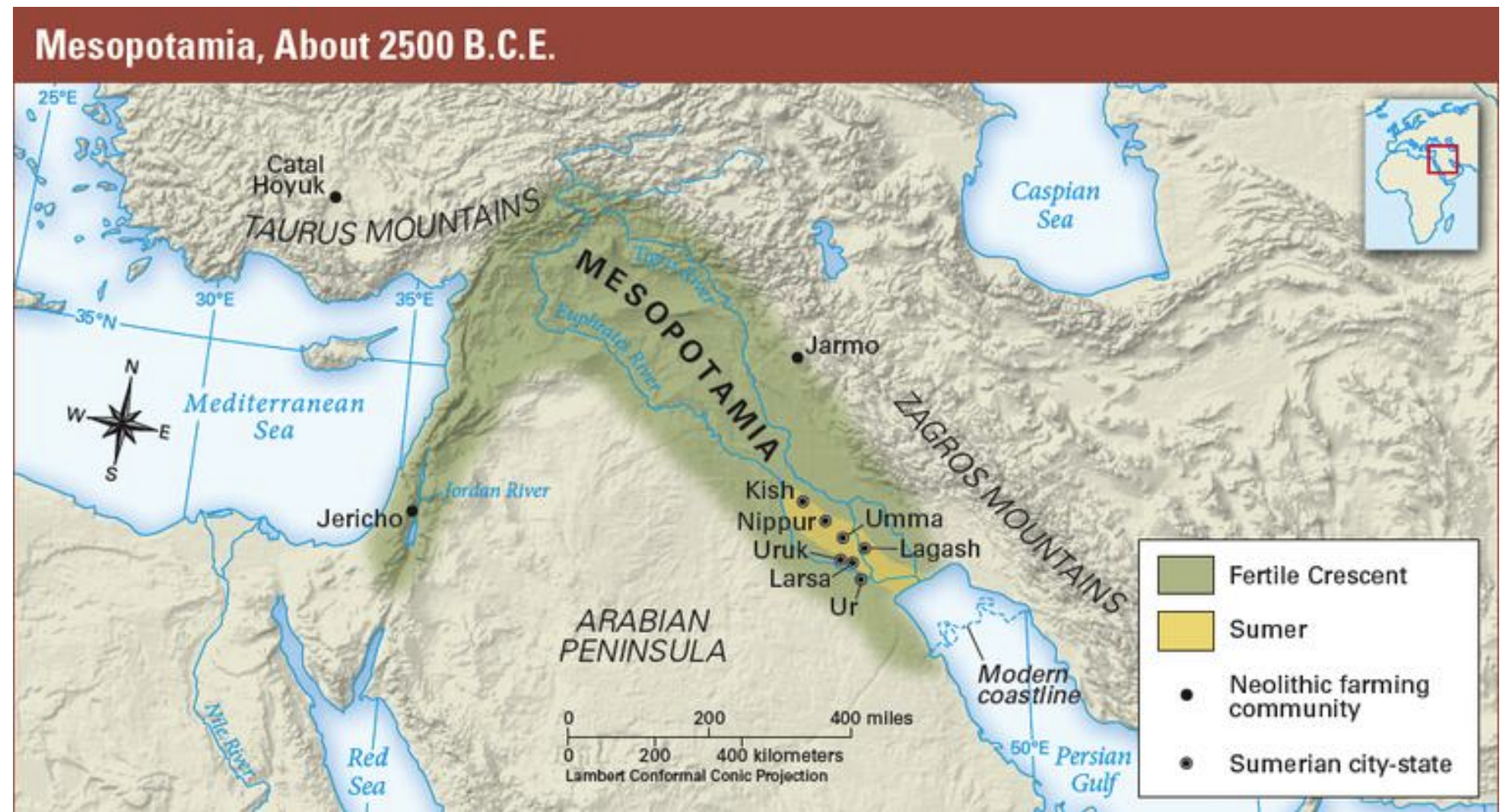 Image Credit: History Alive Textbook
Image Credit: History Alive Textbook
[Sumer was in the area shaded yellow–down in the southern part of Mesopotamia.]
By 2300 B.C.E., Mespotamia was ruled by the Akkadian Empire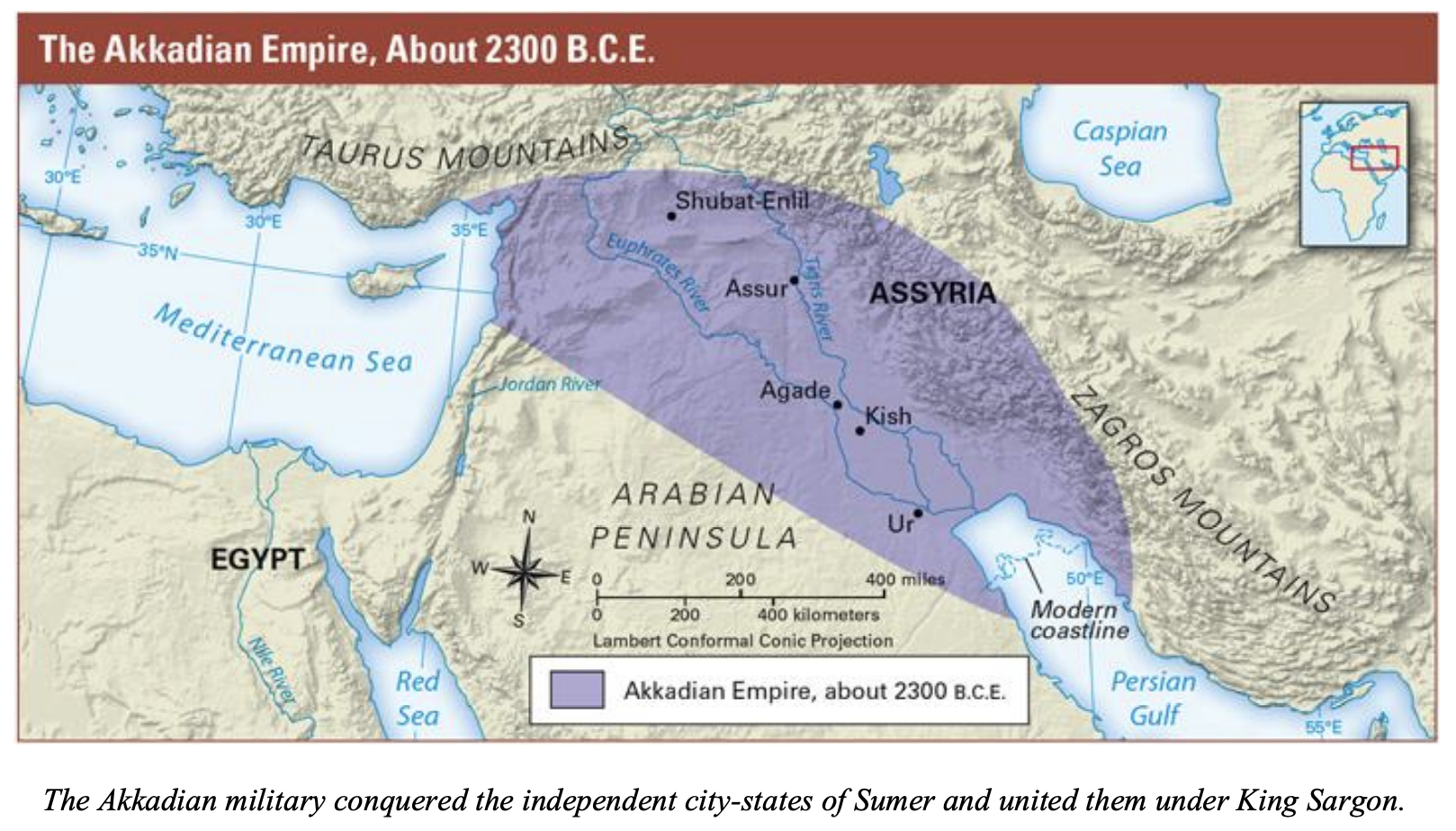
By 1750, Hammurabi had conquere this area, thus initiating the Babylonia Empire.
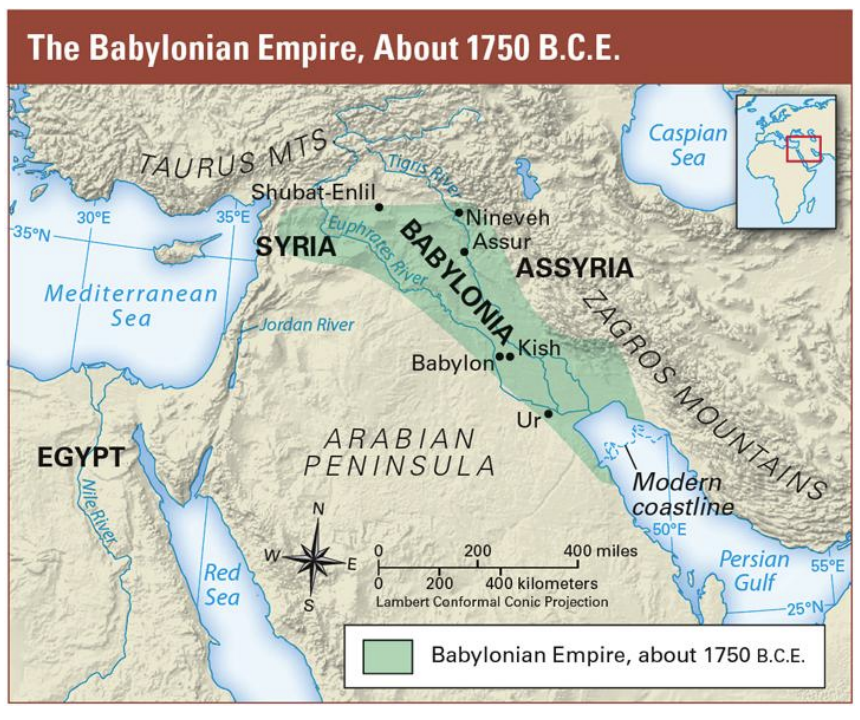 Image Credit: History Alive Textbook
Image Credit: History Alive Textbook
BY 650 B.C.E., The Assyrians ruled Mesopotamia.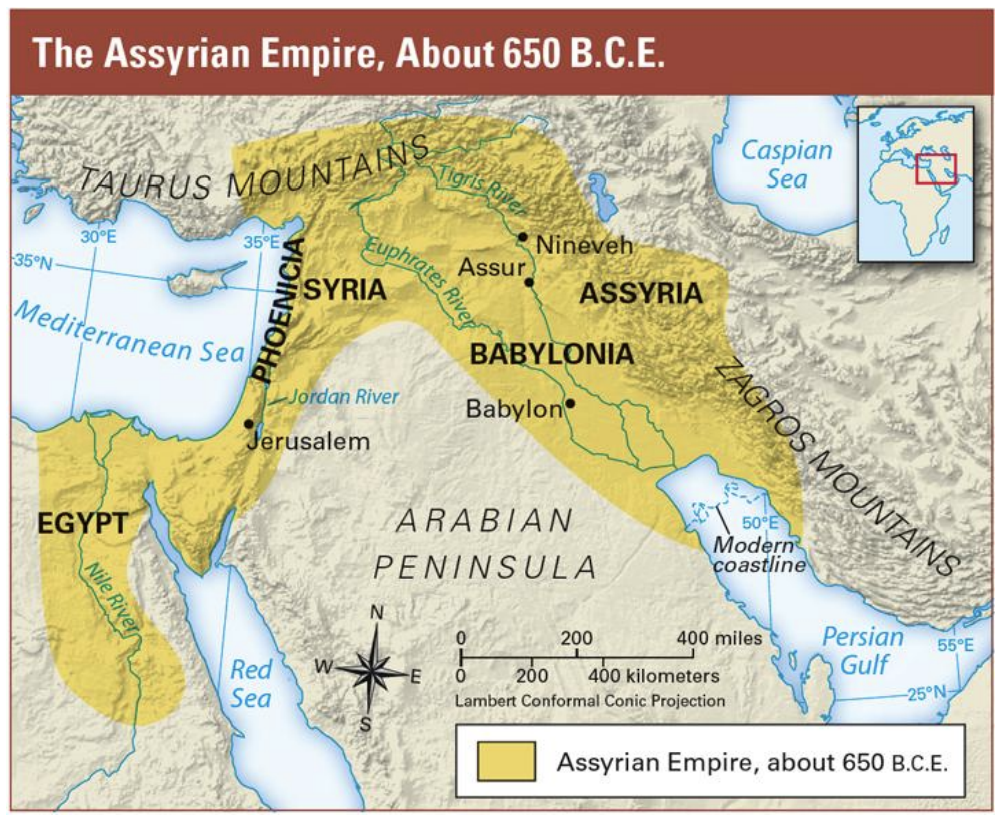 Image Credit: History Alive Textbook
Image Credit: History Alive Textbook
By 600 B.C.E., Mesopotamia beca,e part of the Neo-Babylonian Empire.

Image Credit: History Alive Textbook
Meanwhile, the Egyptians had developed their own civiliation from about 3100 to 300 B.C.E.
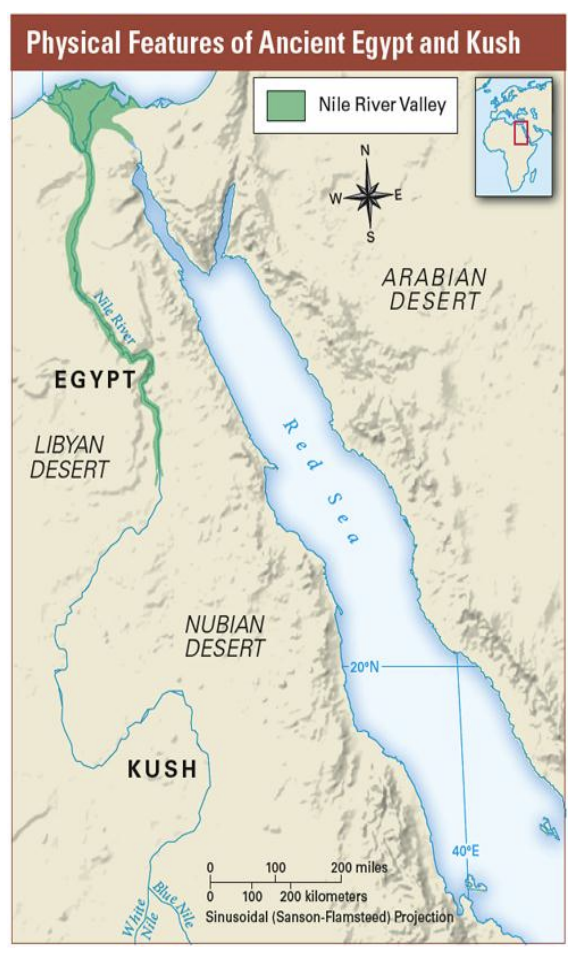
Image Credit: History Alive Textbook
“The Egyptians settled along the Nile River, in the northeast corner of Africa. Their civilization lasted from around 3100 B.C.E. to 350 C.E.
Likewise, the Greeks had developed their own civiliation from by 800 B.C.E., but the Greek Minoan culture dates back to about 3000 B.C.E. The Greeks were traders, and Greek ships carried cargo and the Greeks to launch colonies in many other parts of the world.
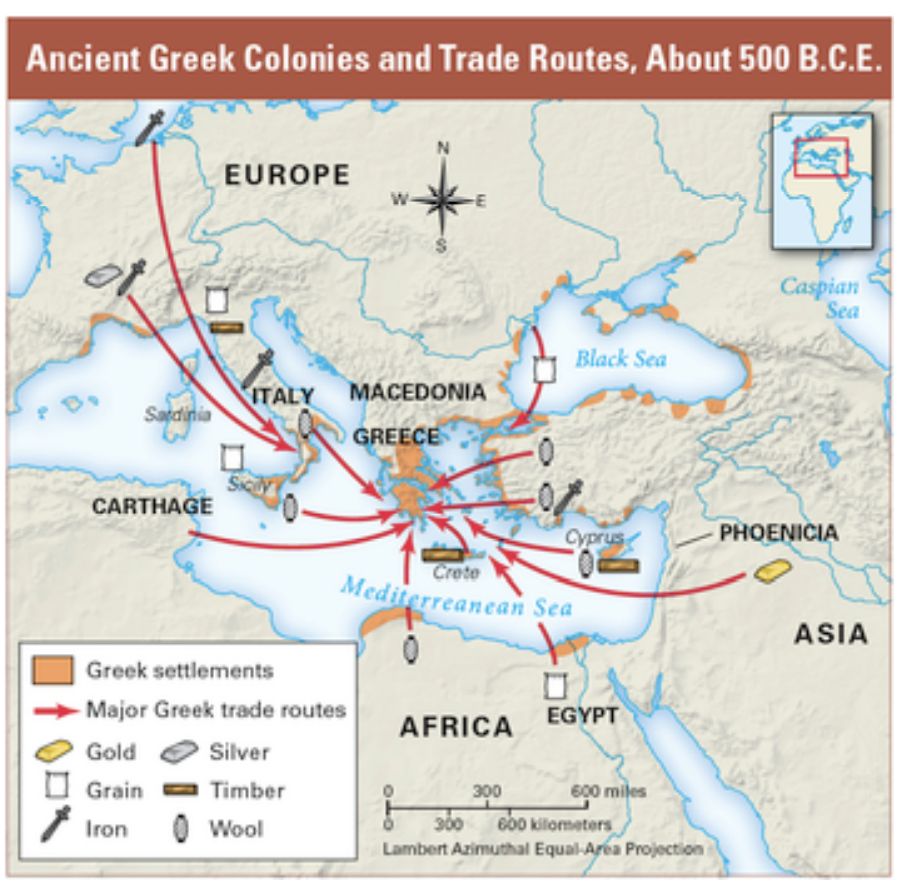 . Image
. Image
One of the Greek colonies was Ionia, which was part of Asia Minor. This resulted in conflict between the Persian Asia Minor and Greece. By 400 B.C.E., the Persian Empire had assumed control over both Mesopotamia and Egypt. It also wanted to gain control of Greece.  “In the 400s B.C.E., the vast Persian Empire extended from the Middle East and northeastern Africa to modern-day Pakistan. The Persians wanted to claim Greece as well.”Image Credit: History Alive Textbook
“In the 400s B.C.E., the vast Persian Empire extended from the Middle East and northeastern Africa to modern-day Pakistan. The Persians wanted to claim Greece as well.”Image Credit: History Alive Textbook
“Athens and Sparta were two very different city-states in ancient Greece. Their differences sometimes led to a distrust of each other. But between 499 and 479 B.C.E., these city-states had a common enemy—the Persian Empire. At that time, Persia was the largest empire the world had ever seen. Its powerful kings ruled over lands in Africa, the Middle East, and Asia.
“During the 400s B.C.E., the Persians invaded Greece, and the Persian wars began. To fight the Persians, the Greek city-states eventually joined together as allies. Allies are states that agree to help each other against a common enemy….
The Persian Empire and the Ionian Revolt
“The Persians started out as a small group of nomads, in what is now Iran. On the following map, Iran is marked by a red arrow. The following map is a modern map. Mesopotamia wouldbe in the area of Iraq. Iran is west of Iran and Israel.
“They built a large empire by conquering neighbors. By unleashing a storm of arrows that surprised their enemies, Persian archers won many battles, often before their opponents could get close enough to use their lances, or spears.
“At its height, the Persian Empire extended from Egypt, in North Africa, east to the Indus River in present-day Pakistan. The empire was ruled by powerful kings who conquered Mesopotamia, Asia Minor, Egypt, and parts of India and Europe.
 .
.
“This detail from a piece of painted pottery shows King Darius of Persia conducting a council of war.”
Image Credit: History Alive Textbook
“King Darius ruled Persia from 522 to 486 B.C.E. The Ionian Revolt, which began in 499 B.C.E., led to the start of the Persian wars. Earlier, in 546 B.C.E., the Persians had conquered the wealthy Greek settlements in Ionia, a small coastal region bordering the Aegean Sea, in Asia Minor.
“The Persians took the Ionians’ farmland and harbors. They forced the Ionians to pay tributes, or the regular payments of goods. The Ionians also had to serve in the Persian army. The Ionians knew that they could not defeat the Persians by themselves, so they asked mainland Greece for help.
“Athens sent soldiers and a small fleet of ships. Unfortunately for the Ionians, the Athenians went home after an initial success, leaving the small Ionian army to continue fighting alone.
“In 493 B.C.E., the Persian army defeated the Ionians.
“To punish the Ionians for rebelling, the Persians destroyed the city of Miletus (my-LEE-tuhs). 28.3 –
The Battle of Marathon

Image Credit: History Alive Textbook
“After the Ionian Revolt, King Darius of Persia was determined to conquer the city-states of mainland Greece. He sent messengers to Greece to ask for presents of Greek earth and water. These gifts would be a sign that the Greeks had agreed to accept Persian rule. But the Greeks refused to hand over the tribute. Instead, they threw the Persian messengers into pits and wells.
“According to legend, the Greeks then shouted, “If you want Greek earth and water, help yourselves!” Darius was furious. In 490 B.C.E., he sent about 15,000 foot soldiers and cavalry across the Aegean Sea by boat to Greece.
 Image Credit: History Alive Textbook
Image Credit: History Alive Textbook
“The Persian army assembled on the plain of Marathon, near the city-state of Athens.
“A brilliant Athenian general named Miltiades (mil-TAHY-uh-deez) convinced the Athenians that it was vital to fight the Persians at Marathon. The Athenians quickly gathered an army of about 11,000 soldiers.
“Although the Athenians were outnumbered, two factors helped them defeat the Persians.
“The first was better weapons. The Greeks’ swords, spears, and armor were superior to the Persians’ weapons.
“The second factor that helped the Athenians defeat the Persians was military strategy. Miltiades assembled his army across a narrow valley. For several days, both sides hesitated to attack. Finally, Miltiades decided to attack. He commanded the center portion of his army to advance. As the Persians came forward to meet them, Miltiades ordered soldiers from the left and from the right portions of his army to sweep down as well, attacking the Persians on three sides. It was not long before the Persian soldiers began running for their ships. Then the Greeks marched back to Athens, in time to defend the city against the Persian cavalry.
“The Persians lost about 6,400 soldiers. The Greeks lost 192. A clever military strategy and better weapons helped the Athenians win a stunning victory. But this battle with the Persians marked only the beginning of the Persian wars.

“In this painting of the Battle of Thermopylae, a smaller force of Spartans (in the background) fights to hold off the huge invading Persian army (in the foreground).” Image Credit: History Alive Textbook
The Battle of Thermopylae
“After King Darius died, his son, Xerxes (zurk-seez), organized another attack on Greece.
“King Xerxes gathered a huge army of more than 180,000 soldiers. To get this army from Persia to Greece, Xerxes chose to cross the Hellespont (HEL-uh-spont), a narrow sea channel between Europe and Asia. There, he created two bridges by roping hundreds of boats together and laying wooden boards across their bows. In this way, his army was able to “walk” across the channel into Europe.
“In 480 B.C.E., Xerxes marched west from the Hellespont and then turned south. His forces overwhelmed several Greek city-states. Hearing the news, Athens and Sparta decided to work together to fight the enemy. Their strategy had two parts. The Athenian navy would try to stop the Persian navy. In the meantime, the Spartan king, Leonidas (lee-ON-ih-duhs), would try to stop the Persian army.
“The Spartans made their stand at Thermopylae (therMOP-uh-lee). At this site, the Persian army would have to go through a narrow pass between the mountains and the sea.
“Leonidas had only about 6,000 to 7,000 soldiers to stop nearly 180,000 Persians. Even so, when the Persians got to the pass, the Greeks drove them back.
“Then a Greek traitor showed the Persians a secret path in the mountains. The path allowed the Persians to surround the Greeks, attacking them from the front and the rear.
“Leonidas knew he could only delay the attackers now. To save his army, he ordered most of his troops to escape. He prepared to fight with his remaining soldiers, including about 300 Spartans. Legend says that the Spartans fought until every weapon was broken. Then they fought with their hands.
“In the end, all the Spartan soldiers were killed. The Persians’ strategy had worked. By having the advantage of the path through the mountains, the Persians won the battle and could now advance to Athens.
 .
.
“At the Battle of Salamis, the Greeks lured the Persians into a narrow channel, where the Greek ships rammed the Persian ships. Here, a Greek ship is about to destroy a Persian ship.” Image Credit: History Alive Textbook
The Battle of Salamis
“In 480 B.C.E., as news of the Greek defeat at Thermopylae reached Athens, its citizens panicked. They boarded ships and sailed for nearby islands. Only a small army of Athenians was left to defend the city.
“Within two weeks, the Persians had burned Athens to the ground. An Athenian navy leader, Themistocles (thuh-MIS-tuhkleez), thought that he knew a way to defeat the Persians. He wanted to fight their navy in the narrow channels between the Greek islands and the Greek mainland.
“The Persians would find it hard to move their ships around to attack the Greek navy. For his plan to work, Themistocles had to get the Persian ships into a channel near a place called Salamis (SAL-uh-mis). So he set a trap. He sent a loyal servant to Xerxes’ camp, with a message saying that Themistocles wanted to change sides and join the Persians.
“If Xerxes attacked now, the message said, half the Greek sailors would surrender. Believing the message, Xerxes ordered his ships to attack. They quickly sailed into the narrow waterway between Salamis and the mainland. As the Persians approached, the Greek ships appeared to retreat. But this was another trick to draw the Persians farther into the channel.
“Soon, the Greeks had them surrounded. The Greeks had attached wooden rams to the front of their ships. They rammed into the Persian boats, crushing their hulls and sinking 300 ships. The Greeks lost only 40 ships. Once again, the Greeks had defeated the mighty Persian Empire.
“At Salamis, the Greeks combined military strategy with their knowledge of coastal geography to influence the outcome of the battle.
The Battle of Plataea
“In 480 B.C.E, after the defeat of the Persians at Salamis, Xerxes fled with some of his soldiers. He was afraid that the Greeks would reach the Hellespont first and destroy the bridges he had built. As it turned out, the bridges had already been wrecked by a bad storm.
“Xerxes had to ferry his men across the water by boat. Xerxes left the rest of the Persian army in Greece, with orders to attack again in the spring. When spring arrived, the Persians approached Athens once more.
“The Spartans feared that the Athenians, with their city already in ruins, would surrender to Persia. But the Athenians proudly declared their “common brotherhood with the Greeks.” They joined with the Spartans to fight the Persians once again.
“The decisive battle took place outside the town of Plataea (pluh-TEE-uh), in 479 B.C.E. Led by the Spartans, a force of 80,000 Greek troops destroyed the Persian army. The alliance between the Athenians and Spartans was a key factor in winning the Battle of Plataea. Most importantly, the Greek victory ended the Persian wars and any future threat from the Persian Empire. The Greeks paid a high price for their defeat of the Persians. Thousands of Greeks were dead, and the city of Athens had been destroyed. But the Athenians would soon rebuild their city and raise it to an even greater glory.” History Alive Textbook
Discover more from Jacki Kellum
Subscribe to get the latest posts sent to your email.